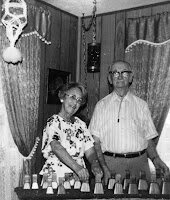Family Life
One Wednesday, January 7th, 1891 at 7:30 p.m. Peter "Pete" Schmidt was born. Perhaps he was named for Uncle Peter Regier, the minister. Hierschau by Helmut Huebert, 1986.
Peter married later in life and didn't have children. He and Edna were famous for their wide repertoire of songs that they played on their cow bells. They entertained the "old folks" at retirement homes.
Jacob "Jake", my grandfather, was born two years later on Wednesday, March 22, 1893 at 10:00 p.m. He married Anna Thesman and had 5 children who lived to adulthood. He was famous for his potato chip factory in Enid, Oklahoma.
 |
| Jake and Anna Thesman Schmidt 1917 |
 |
| Elizabeth Schmidt and Jacob Voth 1916 |
The last baby born to Abraham and Katharina was Nickolaus "Nick". He was born on January 15, 1898. Nick married Susan Wiebe and they had three children.
 |
| Nick Schmidt 1950 |
So while there was a lot of help, both for the housework and the farm work, there was still a lot of work to be done. With ten babies in 16 years (don't forget Susannah), I guess Katharina had had enough. At the age of only 36, she had no more children.
Katharina was a strong-willed person. Having had her children, she set out to do her best for them. They were obviously healthy, since they didn't die in an age when a common cold could kill. And, as mentioned earlier, she made sure that they were educated. That included a musical education.
Music
From my research I find a long tradition of singing in the Mennonite church. Before 1760's in Poland/Prussia hymnbooks were not common. They were too expensive and they might not include the songs the church wanted to use. When the Mennonites arrived in Russia they used a "liner" or "vorsaenger". This person started the songs, set the pitch, tempo and mood, and then he chose which tune would be sung with which text. He needed a strong voice to prompt the congregation by speaking the next words while others were singing. He did use a tuning fork to help him find the key.
Next came the development of "Zifferngesang" (cipher singing) to replace "Gehoermelodie" or (ear singing). Ciphered/numbered singing caused a discussion and disruption in the church for many years from 1839 to 1870.
 |
| An example of numbered notation for the tune. Click on this picture to make it larger. |
Here again, our Katharina R Schmidt was different. She had a tradition of musicianship in her family. She not only played the violin but also taught her son A.A. to play it. His daughter Joanne Olfert now has Katharina's violin.
Of course, all of Katharina's children sang. The four brothers often sang as a quartet in church and at community functions. A.A., Henry, Pete, Jake and Nick received their college degrees in music. A.A. taught music at his mission; Henry was a professor of music in Texas; Jake sang opera with a civic group in Enid; Nick directed his church choir in California; and at the age of 85, Pete was still playing and singing for the "old folks". Mary's children were proud of her lovely alto singing voice and Elizabeth played the organ in her home.
Everyone sang at Christmas. It was a very religious holiday for our ancestors. In spite of the houseful of children, gifts were not the focus of the holiday.Christmas trees were not allowed in the Mennonite church until after 1926. Dorothy Schmidt remembers returning from performing at an Englishcher church in the 1930's. Her mother, Anna Thesman Schmidt, remarked that the Christmas tree in the church was like an idol interfering with the worship.
Here is song that was traditional at Christmas in these households: (Click on the arrow in the middle of the box to hear the song.)
The Mennonite Brethren made a three-day holiday out of Christmas and enjoyed the chance to visit each other at home and at church. Services were held both Christmas Eve and morning with additional celebrations taking the form of musical performances, and, as always, plenty of food.
Since there wasn't a tree, Abraham and Katharina put the presents on each person's place at the table. A slip of paper with the person's name written on it was placed there with their "tute". Relatives gave the children "tutes" or sacks containing a piece of fruit (if they were lucky) some nuts and some candy. Some families and churches continue this tradition today.
One Christmas was not very happy in the Schmidt household. A week before Christmas, 1898, Anna, who was 4 1/2, became ill. For a week or so, through Christmas, they thought it was a bad cold. She had a fever and congestion so she stayed home from the church services. The following week her cough grew worse. It was so bad that she made a whooping sound as she gasped for breath. Katharina nursed her through the night as the congregation added their prayers for her recovery at their traditional New Year's Eve services. Finally, Anna was so weakened that on January 3, 1899, she died from her 16 day struggle.
The following year, Abraham and Katharina sold their 120 acres near Henderson, Nebraska, to her father Johann J. Regier for $3600. The deed was signed on June 2, 1900.
Review:
The Schmidt family had lived in Hamilton County near Henderson, Nebraska for 14 years from 1879 to 1893. Eight of their children were born there.
The next chapter: Why did they move? And where did they move to?

No comments:
Post a Comment
We welcome positive comments, information and help to further this blog. This is not just my story. It is OUR story.